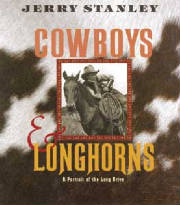|

Cowboys and Longhorns
Stanley, Jerry. 2003. Cowboys and
longhorns: A portrait of the long drive. New York: Crown
Publishers. ISBN: 0375815651.
All of us have grown up with the myth of the great American cowboy. In
this frank and candid study of the history of the American cowboy,
Jerry Stanley paints a picture before his reader of a very different
reality for the legenday hero. The text begins with an overview of
misperceptions and also gives brief hypotheses about how and why these
have been perpetuated in American culture across the decades. From the
frits sentence of chapter one, the reader realizes that Stanley will
dispel these falsehoods and give credit where it is due. Chapter one
begins with, "The first cowboys were of Spanish descent, and the
methods they developed for controlling cattle were copied by American
cowboys." Stanley also tells the history of the longhorn, and then
follows the path of the cowboy and the longhorn on their long journey
across the plains to Kansas. Along the way, Stanley is able to detail
the many dangers faced by both livestock and cowboys.
As the book progresses, it becomes clear that the author will not gloss
over the realities of herding longhorns. Reviewers called Stanley's
prose "gripping," "graphic" (Tilottson, 2004), and "gritty." (Sullivan,
2003) Cowboys often met a gruesome death, and the longhorns were also
in grave danger from both their own wild nature and the means the
cowboys employed to force them into submission. These atrocities are
described in gory detail. At the same time, Stanley uses a friendly and
easy going style as he transports his readers back to these wild times
through lines such as, "It starts in Texas during that period of
history when cowboys were called vaqueros."
(Stanley, p.4) which is the last sentence of the introduction.
Although there is no recurring character, the trek up the Chisholm
Trail itself seems to become the main character as Stanley lays out
each step of the journey and the dangers faced along the way.
Through Stanley's text, one senses his passion for telling the true
story of the cowboy as he dispels one myth after another. The depth of
his research can be seen in the extensive bibliographic note on page
78. Sources are arranged by subject matter, and the note is written in
paragraph form. Picture credits, acknowledgments, and a thorough index
are also included.
The text itself is printed in a medium-sized serif font. Illustrations
include maps and sketches, portraits and scenes from the lives of real
cowboys, and also pictures of Hollywood's version of the American
cowboy. Stanley is able to use these illustrations to expand upon his
text, such as the justaposition of portraits of the real cowboy and the
Hollywood version on pages one and two of the introduction. A portrait
of Gregory Peck portrays a sharply dressed man with flawless skin
holding a shiny clean rifle and sitting jauntily on a wooden fence with
one leg cocked at an angle. His perfect hat is perched on his head as
he stares out in space. On the next page is a picture of a real cowboy
in profile. His skin is sunburned, his mustache is in need of a trim,
and the brim of his hat is bent and tattered. He is hunched forward and
his jaw is tight with concentration. These pictures bring out the
differences between the two in sharp contrast. Besides the
introduction, the book contains eight chapters, each of which is titled
with a relevant phrase from its text. The first page of each chapter
also contains a silhouetted graphic of things such as a horse and rider
or a longhorn. When there is a shift in the subject matter of a
chapter, this change is marked by a center-justified, stylized "Zia,"
which is a Native American symbol. An example can be seen at
http://www.abqcam.com/zia.htm.
Although this book is at times very graphic, it is also eye-opening. At
the conclusion, the reader is amazed that any cattle and cowboys
actually made it to their destination alive.
|

